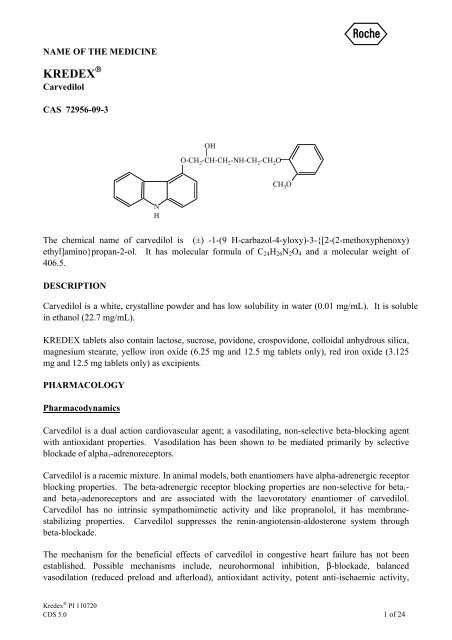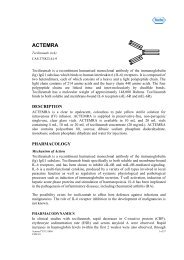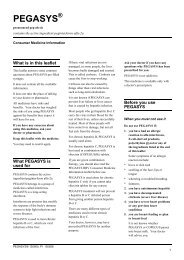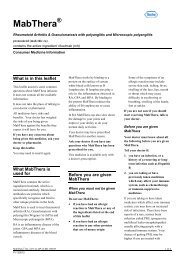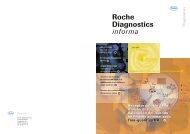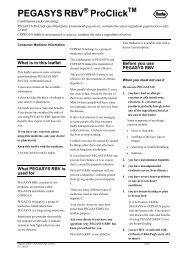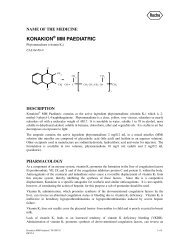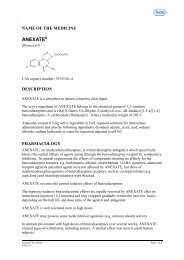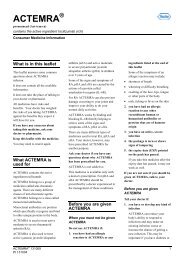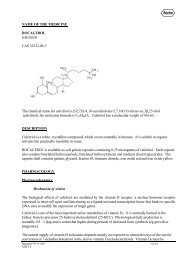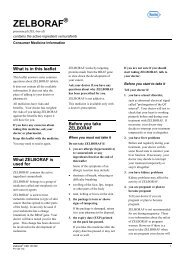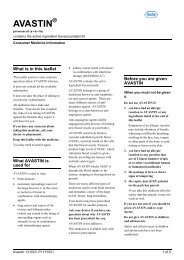Kredex (carvedilol) - Product Information (PI) - Roche Australia
Kredex (carvedilol) - Product Information (PI) - Roche Australia
Kredex (carvedilol) - Product Information (PI) - Roche Australia
Create successful ePaper yourself
Turn your PDF publications into a flip-book with our unique Google optimized e-Paper software.
NAME OF THE MEDICINE<br />
r<br />
KREDEX <br />
Carvedilol<br />
CAS 72956-09-3<br />
OH<br />
O-CH 2 -CH-CH 2 -NH-CH 2 -CH 2 O<br />
CH 3 O<br />
N<br />
H<br />
The chemical name of <strong>carvedilol</strong> is (±) -1-(9 H-carbazol-4-yloxy)-3-{[2-(2-methoxyphenoxy)<br />
ethyl]amino}propan-2-ol. It has molecular formula of C 24 H 26 N 2 O 4 and a molecular weight of<br />
406.5.<br />
DESCRIPTION<br />
Carvedilol is a white, crystalline powder and has low solubility in water (0.01 mg/mL). It is soluble<br />
in ethanol (22.7 mg/mL).<br />
KREDEX tablets also contain lactose, sucrose, povidone, crospovidone, colloidal anhydrous silica,<br />
magnesium stearate, yellow iron oxide (6.25 mg and 12.5 mg tablets only), red iron oxide (3.125<br />
mg and 12.5 mg tablets only) as excipients.<br />
PHARMACOLOGY<br />
Pharmacodynamics<br />
Carvedilol is a dual action cardiovascular agent; a vasodilating, non-selective beta-blocking agent<br />
with antioxidant properties. Vasodilation has been shown to be mediated primarily by selective<br />
blockade of alpha 1 -adrenoreceptors.<br />
Carvedilol is a racemic mixture. In animal models, both enantiomers have alpha-adrenergic receptor<br />
blocking properties. The beta-adrenergic receptor blocking properties are non-selective for beta 1 -<br />
and beta 2 -adenoreceptors and are associated with the laevorotatory enantiomer of <strong>carvedilol</strong>.<br />
Carvedilol has no intrinsic sympathomimetic activity and like propranolol, it has membranestabilizing<br />
properties. Carvedilol suppresses the renin-angiotensin-aldosterone system through<br />
beta-blockade.<br />
The mechanism for the beneficial effects of <strong>carvedilol</strong> in congestive heart failure has not been<br />
established. Possible mechanisms include, neurohormonal inhibition, β-blockade, balanced<br />
vasodilation (reduced preload and afterload), antioxidant activity, potent anti-ischaemic activity,<br />
<strong>Kredex</strong> ® <strong>PI</strong> 110720<br />
CDS 5.0 1 of 24
and inhibition of neutrophil adhesion. Antioxidant activity and inhibition of neutrophil adhesion<br />
have been demonstrated in in vitro and in vivo animal models and in in vitro human models.<br />
Carvedilol reduces the peripheral vascular resistance by vasodilation predominantly mediated<br />
through selective alpha 1 - antagonism and beta blockade prevents reflex tachycardia with the net<br />
result that heart rate is slightly decreased.<br />
In hypertensive patients, a reduction in blood pressure is not associated with a concomitant<br />
increase in total peripheral resistance, as observed with pure beta-blocking agents. Renal<br />
blood flow and renal function are maintained. Peripheral blood flow is maintained, therefore,<br />
cold extremities (often observed with drugs possessing beta-blocking activity) are rarely seen.<br />
Fluid retention does not occur.<br />
In studies that compared the acute haemodynamic effects of <strong>carvedilol</strong> to baseline measurements in<br />
patients with congestive heart failure, there were significant reductions in systemic blood pressure,<br />
pulmonary artery pressure, pulmonary capillary wedge pressure, and heart rate. Initial effects on<br />
cardiac output, stroke volume index and systemic vascular resistance were small and variable.<br />
In terms of chronic haemodynamic effects (12 to 14 weeks) <strong>carvedilol</strong> significantly reduced<br />
systemic blood pressure, pulmonary artery pressure, right atrial pressure, systemic vascular<br />
resistance and heart rate while stroke volume index was increased.<br />
In patients with ischaemic cardiomyopathy, long-term treatment (6 months) with <strong>carvedilol</strong> (6.25,<br />
12.5 and 25mg) reduced left ventricular dimensions measured echocardiographically.<br />
In patients with renal impairment, the autoregulatory blood supply is preserved and the glomerular<br />
filtration is unchanged during chronic treatment with <strong>carvedilol</strong>.<br />
A normal ratio of high density lipoproteins to low density lipoproteins (HDL/LDL) is maintained.<br />
Serum electrolytes are also unaffected.<br />
During one small randomized trial in patients with hypertension and non-insulin dependant diabetes<br />
<strong>carvedilol</strong> exerted no significant effect on fasting glucose, post-prandial glucose concentration and<br />
glycosylated haemoglobin A 1 . In another trial of non-insulin dependant diabetics, <strong>carvedilol</strong> did not<br />
significantly affect glucose tolerance test result. A third trial in hypertensive non-diabetic subjects<br />
with metabolic syndrome and baseline insulin resistance <strong>carvedilol</strong> demonstrated a modest but nonsignificant<br />
increase in insulin sensitivity. A fourth trial demonstrated a decrease in plasma glucose<br />
and insulin responses to a glucose load in hypertensive non insulin dependant diabetics.<br />
<strong>Kredex</strong> ® <strong>PI</strong> 110720<br />
CDS 5.0 2 of 24
Pharmacokinetics<br />
Absorption<br />
Carvedilol is rapidly and extensively absorbed following oral administration. Carvedilol is a<br />
substrate of the intestinal efflux transporter P-glycoprotein which plays a major role in the<br />
bioavailability of certain medicines. The absolute bioavailability of <strong>carvedilol</strong> is approximately<br />
25%. Plasma levels peak approximately 1 hour after an oral dose. Carvedilol undergoes<br />
stereoselective first-pass metabolism with plasma levels of R(+)-<strong>carvedilol</strong> approximately 2 to 4-<br />
fold higher than S(-)-<strong>carvedilol</strong> following oral administration in healthy subjects. Plasma levels<br />
increase in a dose-proportional manner.<br />
No data on the effect of food on <strong>carvedilol</strong> tablets exist. Studies carried out with the capsule<br />
formulation indicate that food does not affect the extent of bioavailability or the maximum plasma<br />
concentration, although the time to reach maximum plasma concentration is delayed.<br />
Distribution<br />
Greater than 98% of <strong>carvedilol</strong> is bound to plasma proteins, primarily albumin. Carvedilol is highly<br />
lipophilic; the volume of distribution is approximately 2 L/kg and is increased in patients with liver<br />
disease. When used as directed, <strong>carvedilol</strong> is unlikely to accumulate during long-term treatment.<br />
Metabolism<br />
In humans, <strong>carvedilol</strong> is extensively metabolized in the liver via oxidation and glucuronidation into<br />
a variety of metabolites which are mainly excreted in the bile. The first-pass effect after oral<br />
administration amounts to about 60-75%; enterohepatic circulation of <strong>carvedilol</strong> and/or its<br />
metabolites has been shown in animals.<br />
The oxidative metabolism of <strong>carvedilol</strong> is stereoselective. The R(+)enantiomer is predominantly<br />
metabolized by CYP2D6 and CYP1A2, while the S(-)enantiomer is mainly metabolised by<br />
CYP2C9 and to a lesser extent by CYP2D6. Other CYP450 isoenzymes involved in the metabolism<br />
of <strong>carvedilol</strong> include CYP3A4, CYP2E1 and CYP2C19. The maximum plasma concentration of R-<br />
<strong>carvedilol</strong> is approximately 2 fold higher than that S-<strong>carvedilol</strong>. Although results from in vitro<br />
studies demonstrate that <strong>carvedilol</strong> has inhibitory potential against several P450s (CYP1A2,<br />
CYP2C9/8, CYP2C19, CYP3A and CYP2D6), it is important to note that the estimated IC 50 values<br />
(concentration of <strong>carvedilol</strong> required to produce 50% inhibition of the CYP450 isoenzymes) for the<br />
R(+) and S(-) enantiomers are substantially higher than their circulating peak plasma levels<br />
achieved during therapy.<br />
The R(+)enantiomer is predominantly metabolised through hydroxylation.<br />
Poor metabolisers of debrisoquine (a marker for CYP2D6) exhibited 2-to 3-fold higher plasma<br />
concentrations of R(+) <strong>carvedilol</strong>, compared to extensive metabolisers. In contrast, plasma levels<br />
for S(-) <strong>carvedilol</strong> were only increased by about 20-25% in poor metabolisers. As R(+) <strong>carvedilol</strong> is<br />
only responsible for alpha-blocking activity, it would be anticipated that, on average, poor<br />
metabolisers of debrisoquine would have greater alpha-blockade after <strong>carvedilol</strong> administration<br />
with little change in beta-blocking activity, compared to extensive metabolisers (see drug<br />
interactions).<br />
<strong>Kredex</strong> ® <strong>PI</strong> 110720<br />
CDS 5.0 3 of 24
The pharmacokinetics of <strong>carvedilol</strong> do not appear to be different in poor metabolisers of S-<br />
mephenytoin (patients deficient in CYP2C19).<br />
Demethylation and hydroxylation at the phenol ring produces three active metabolites with betareceptor<br />
blocking activity. Based on preclinical studies, the 4’-hydroxyphenol metabolite is<br />
approximately 13 times more potent than <strong>carvedilol</strong> for beta-blockade. Compared to <strong>carvedilol</strong>, the<br />
three active metabolites exhibit weak vasodilating activity. In humans, the concentrations of the<br />
three active metabolites are about 10 times lower than that of the parent substance. According to an<br />
in vitro study using rat brain homogenate, two of the hydroxy-carbazole metabolites of <strong>carvedilol</strong><br />
are extremely potent antioxidants, demonstrating a 30 to 80 fold greater potency than <strong>carvedilol</strong>.<br />
Clinical significance remains to be established.<br />
Elimination<br />
After oral administration, the elimination half-life of <strong>carvedilol</strong> is approximately 6 to 10 hours.<br />
Plasma clearance ranges from 500 to 700 mL/min. Elimination is mainly biliary, with the primary<br />
route of excretion being via the faeces. A minor portion is eliminated via the kidneys.<br />
The pharmacokinetics of <strong>carvedilol</strong> are affected by age. AUC and Tmax values are increased in the<br />
elderly. Plasma levels of <strong>carvedilol</strong> are approximately 50% higher in the elderly compared to<br />
young subjects.<br />
Steady-state plasma concentrations of both <strong>carvedilol</strong> enantiomers increased proportionally over the<br />
6.25 to 50 mg dose range in patients with congestive heart failure. Compared to healthy subjects,<br />
congestive heart failure patients had increased mean AUC and C max values for both <strong>carvedilol</strong><br />
enantiomers with up to 50% to 100% higher values observed in Class IV patients. The mean<br />
apparent terminal elimination half-life for <strong>carvedilol</strong> was similar to that observed in healthy<br />
subjects.<br />
Pharmacokinetics in Special Populations<br />
Patients with renal impairment<br />
In patients with hypertension and renal insufficiency, the area under plasma level-time curve,<br />
elimination half-life and maximum plasma concentration do not change significantly. Following a<br />
single dose (12.5mg) the mean ± SD of AUCs on day 1 were 220±120 in patients with renal<br />
impairment and 165±83.5ng.h/mL in controls. Following multiple doses (25mg daily) and on day 9,<br />
the corresponding AUCs were 618 ± 335 in patients with renal impairment and 413 ± 247ng.h/mL<br />
in controls. Renal excretion of the unchanged drug decreases in the patients with renal<br />
insufficiency; however changes in pharmacokinetic parameters are modest for racemic <strong>carvedilol</strong><br />
and R(+)<strong>carvedilol</strong>.<br />
Carvedilol causes a gradual reduction in blood pressure both on dialysis and non-dialysis days, and<br />
the blood pressure-lowering effects are comparable with those seen in patients with normal renal<br />
function. Carvedilol is not eliminated during dialysis because it does not cross the dialysis<br />
membrane, probably due to its high plasma protein binding.<br />
<strong>Kredex</strong> ® <strong>PI</strong> 110720<br />
CDS 5.0 4 of 24
Patients with hepatic impairment<br />
In patients with cirrhosis of the liver, the systemic availability of the drug is increased up to four<br />
fold because of a reduction in the first-pass effect (absolute bioavailability 18.6% in 19 controls and<br />
82.5% in 5 patients). Therefore, <strong>carvedilol</strong> is contraindicated in patients with clinically manifest<br />
liver dysfunction (see Contraindications).<br />
Patients with heart failure<br />
In a study in 24 patients with heart failure, the clearance of R-and S-<strong>carvedilol</strong> was significantly<br />
lower than previously estimated in healthy volunteers. These results suggested that the<br />
pharmacokinetics of R-and S-<strong>carvedilol</strong> is significantly altered by heart failure.<br />
Geriatric use<br />
Age has no statistically significant effect on the pharmacokinetics of <strong>carvedilol</strong> in hypertensive<br />
patients. A study in elderly hypertensive patients showed that there was no significant difference in<br />
the adverse event profile compared to younger patients. Another study which included elderly<br />
patients with coronary heart disease showed no significant difference in the adverse events reported<br />
vs those reported by younger patients.<br />
Paediatric use<br />
There is limited data available on pharmacokinetics in people younger than 18 years of age.<br />
Clinical Trials<br />
The use of this agent in congestive heart failure (CHF) patients has been shown to reduce<br />
cardiovascular hospitalisation, improve patient well-being, slow the progression of the disease and<br />
reduce the risk of death.<br />
Four U.S. multicentre, double-blind, placebo-controlled studies enrolled 1094 patients (696<br />
randomised to <strong>carvedilol</strong>) with New York Heart Association (NYHA) class II - III heart failure and<br />
ejection fraction
assignment of significance values to the other results is complex, and such values need to be<br />
interpreted cautiously.<br />
The results of the U.S. and <strong>Australia</strong>-New Zealand trials were as follows:<br />
Slowing Progression of Heart Failure: One U.S. multicentre study (366 subjects) had as its<br />
primary end-point the sum of cardiovascular mortality, cardiovascular hospitalisation and sustained<br />
increase in heart failure medications. Heart failure progression was reduced, during an average<br />
follow-up of 7 months, by 48% (p=0.008).<br />
In the <strong>Australia</strong>-New Zealand study, death and total hospitalisations were reduced by about 25%<br />
over 18-24 months. In the three largest U.S. studies, death and total hospitalisations were reduced<br />
by 19%, 39% and 49%, these results being nominally statistically significant in the last two studies.<br />
The <strong>Australia</strong>- New Zealand results were statistically borderline.<br />
Functional Measures: None of the multicentre studies had NYHA classification as a primary endpoint,<br />
but all such studies had it as a secondary end-point. There was at least a trend toward<br />
improvement in NYHA class in all studies. Exercise tolerance was the primary end-point in 3<br />
studies; in none was a statistically significant effect found.<br />
Subjective Measures: Quality of life, as measured with a standard questionnaire (a primary endpoint<br />
in one study), was unaffected by <strong>carvedilol</strong>. However, patients’ and investigators’ global<br />
assessments showed significant improvement in most studies.<br />
Mortality: Mortality was not a planned endpoint in any study. Overall the results from four US<br />
studies are consistent with a beneficial effect of <strong>carvedilol</strong> on mortality due to the consistency of the<br />
results seen across different trials. However, the actual effect, size and statistical difference of this<br />
observation are difficult to define.<br />
Severe Congestive Heart Failure (COPERNICUS) Trial<br />
In a large, multi-centre, double-blind, placebo-controlled mortality trial (COPERNICUS), 2289<br />
patients with stable, severe, CHF of ischaemic, or non-ischaemic origin, on standard therapy, were<br />
randomised to either <strong>carvedilol</strong> (1156 patients) or placebo (1133 patients). Patients had left<br />
ventricular systolic dysfunction with a mean ejection fraction of < 20%, sitting systolic blood<br />
pressure ≥ 85 mmHg, no more than trace edema of the peripheral limbs, no new pulmonary rales or<br />
ascites, optimisation of diuretic therapy and other established therapy such as ACE inhibitors and<br />
angiotensin-II antagonists, no recent unstable angina, cardiac surgery or ventricular arrhythmias and<br />
<strong>Kredex</strong> ® <strong>PI</strong> 110720<br />
CDS 5.0 6 of 24
no recent use of intravenous positive inotropic or vasodilator agents (other than digitalis). The<br />
primary efficacy parameter was all-cause mortality and the secondary efficacy parameters were<br />
defined as combined mortality or hospitalisations for heart failure, mortality or cardiovascular<br />
hospitalisations and mortality or all-cause hospitalisations. Interim analyses were conducted to<br />
determine whether the Data Safety Monitoring Board (DSMB) could recommend the study to be<br />
terminated early due to convincing evidence of benefit or harm. Deaths were classified as either<br />
cardiovascular or non-cardiovascular, and within the group of cardiovascular deaths as being due to<br />
left ventricular dysfunction or other cardiovascular causes.<br />
Efficacy results<br />
At the fourth interim analysis, the upper interim monitoring boundary was exceeded, indicating a<br />
statistically significant survival benefit for patients on <strong>carvedilol</strong>. As a result, the DSMB<br />
recommended early termination of the trial<br />
Primary Efficacy Parameter<br />
The rate of survival was significantly higher in the patients receiving <strong>carvedilol</strong> than the placebo<br />
group. The benefit of <strong>carvedilol</strong> became apparent after about 100 days of treatment. All-cause<br />
mortality was reduced by 35% from 19.7% in the placebo group to 12.8% in the <strong>carvedilol</strong> group<br />
(Cox proportional hazards, p=0.00013). The mortality benefit of <strong>carvedilol</strong> was consistent across<br />
all sub-populations investigated. The most frequent cause of death, sudden death, was reduced by<br />
41% in the <strong>carvedilol</strong> group (5.3% vs 8.9%).<br />
Figure 1-<br />
Secondary Efficacy Parameters<br />
Hospitalisations due to worsening heart failure, cardiovascular hospitalisations and all<br />
hospitalisations were significantly reduced under <strong>carvedilol</strong> therapy. Thus, the combined risk of<br />
<strong>Kredex</strong> ® <strong>PI</strong> 110720<br />
CDS 5.0 7 of 24
death or hospitalisation due to worsening heart failure was reduced by 31% (p=0.000004), death or<br />
cardiovascular hospitalisation by 27% (p=0.000023) and death or all hospitalisation by 24%<br />
(p=0.00004).<br />
Table 1- One-year Kaplan-Meier estimates of the incidences of the combined endpoints death<br />
or hospitalisations, hazard ratio estimates and log-rank p values.<br />
ITT Population<br />
Total<br />
Events<br />
Placebo<br />
One-Year<br />
K-M<br />
Estimate<br />
Placebo<br />
Total<br />
Events<br />
Carvedilol<br />
One-Year<br />
K-M<br />
Estimate<br />
Carvedilol<br />
Hazard<br />
Ratio<br />
(Carvedilol<br />
vs Placebo)<br />
(95% CI)<br />
p Value<br />
(Log-Rank<br />
Test)<br />
% Risk<br />
Reduction<br />
Death or<br />
hospitalisations<br />
for heart failure<br />
357 0.379 271 0.255<br />
0.691<br />
(0.590, 0.809)<br />
0.000004 31<br />
Death or<br />
cardiovascular<br />
hospitalisations<br />
395 0.417 314 0.302<br />
0.727<br />
(0.627, 0.843)<br />
0.000023 27<br />
Death or all<br />
hospitalisations<br />
507 0.523 425 0.416<br />
0.764<br />
(0.671, 0.869)<br />
0.000040 24<br />
The majority of patients were hospitalised for cardiovascular reasons. Treatment with <strong>carvedilol</strong><br />
resulted in lower rates for almost all cardiac hospitalisations (worsening heart failure, atrial and<br />
ventricular and tachyarrhythmias, myocardial infarction and unstable angina pectoris). The number<br />
of patients hospitalised for symptomatic bradycardia and symptomatic heart block were slightly<br />
higher in the <strong>carvedilol</strong> treated patients than placebo, although the total number of patients<br />
hospitalised was low (1.3% and 0.8% respectively for bradycardia and 0.3% and 0.1% respectively<br />
for heart block). The number of patients hospitalised for non-cardiovascular events was similar in<br />
both groups (placebo 11.2%, <strong>carvedilol</strong> 10.6%).<br />
INDICATIONS<br />
KREDEX is indicated for the treatment of hypertension. Data have not been provided to support the<br />
use of this drug in renovascular disease.<br />
KREDEX is indicated for the treatment of patients with symptomatic mild to severe (NYHA<br />
Class II - IV) congestive heart failure (CHF) as an adjunct to conventional treatments (e.g.<br />
diuretics, digoxin, ACE inhibitors and vasodilators).<br />
<strong>Kredex</strong> ® <strong>PI</strong> 110720<br />
CDS 5.0 8 of 24
CONTRAINDICATIONS<br />
r<br />
KREDEX must not be used in patients with:<br />
• New York Heart Association (NYHA) Class IV decompensated heart failure requiring<br />
intravenous inotropic support.<br />
• Bronchial asthma (two cases of death from status asthmaticus have been reported in patients<br />
receiving single doses of <strong>carvedilol</strong>) or related bronchospastic conditions including chronic<br />
obstructive pulmonary disease (COPD) with a bronchospastic component.<br />
• Allergic disorders (including Asthma and allergic rhinitis) which may suggest a predisposition to<br />
bronchospasm.<br />
• Severe sinus bradycardia (less than 45 to 50 beats per minute) or sick sinus syndrome (unless a<br />
permanent pacemaker is in place).<br />
• Shock (including cardiogenic and hypovolaemic shock)<br />
• Second and third degree atrioventricular block.<br />
• Known hypersensitivity to KREDEX.<br />
• Hepatic impairment; KREDEX is contraindicated in patient with clinically manifest liver<br />
dysfunction<br />
• Severe hypotension (systolic blood pressure
Bradycardia: In clinical trials, KREDEX caused bradycardia in about 2% of hypertensive patients<br />
and 9% of congestive heart failure patients. If pulse rate drops below 55 beats/minute, the dosage<br />
should be reduced.<br />
Hypotension: Hypotension and postural hypotension occurred in 9.7% and syncope in 3.4% of<br />
congestive heart failure patients receiving KREDEX compared to 3.6% and 2.5% of placebo<br />
patients, respectively. The risk for these events was highest during the first 30 days of dosing,<br />
corresponding to the up-titration period and was a cause for discontinuation of therapy in 0.7% of<br />
KREDEX patients, compared to 0.4% of placebo patients.<br />
To decrease the likelihood of syncope or excessive hypotension, treatment should be initiated with<br />
3.125 mg b.i.d. for congestive heart failure patients. Dosage should then be increased slowly,<br />
according to recommendations in the DOSAGE AND ADMINISTRATION section, and the drug<br />
should be taken with food. During initiation of therapy, the patient should be cautioned to avoid<br />
situations such as driving or hazardous tasks, where injury could result should syncope occur.<br />
Labile Hypertension: KREDEX should be used with caution in patients with labile or<br />
secondary hypertension until further clinical experience is available.<br />
Peripheral Vascular Disease: Beta-blockers can precipitate or aggravate symptoms of arterial<br />
insufficiency in patients with peripheral vascular disease. Caution should be exercised in such<br />
individuals.<br />
Raynaud's phenomenon: KREDEX should be used with caution in patients suffering from<br />
peripheral circulatory disorders (eg Raynaud's phenomenon) as there may be exacerbation of<br />
symptoms.<br />
Hypertensive Patients with Left Ventricular Failure: In hypertensive patients who have<br />
congestive heart failure controlled with digitalis, diuretics and/or an angiotensin-converting enzyme<br />
inhibitor, KREDEX (<strong>carvedilol</strong>) may be used. However, since it is likely that such patients are<br />
dependent, in part, on sympathetic stimulation for circulatory support, it is recommended that<br />
dosing follow the instructions for patients with congestive heart failure.<br />
Psoriasis: Patients with a history of psoriasis associated with β-blocker therapy should take<br />
KREDEX only after consideration of the risk-benefit ratio.<br />
Concomitant use of calcium channel blockers: Careful monitoring of ECG and blood pressure is<br />
necessary in patients receiving concomitant therapy with calcium channel blockers of the verapamil<br />
or diltiazem type or other antiarrhythmic drugs (see Drug Interactions)<br />
Hepatic Injury: Mild hepatocellular injury, confirmed by rechallenge, has occurred rarely with<br />
KREDEX therapy.<br />
In controlled studies of congestive heart failure, the incidence of liver function abnormalities<br />
reported as adverse experiences was 5.0% (38 0f 765 patients) in patients receiving KREDEX and<br />
<strong>Kredex</strong> ® <strong>PI</strong> 110720<br />
CDS 5.0 10 of 24
4.6% (20 of 437 patients) in those receiving placebo. Three patients receiving <strong>carvedilol</strong> (0.4%) and<br />
two patients receiving placebo (0.5%) in placebo-controlled trials withdrew for abnormal hepatic<br />
function.<br />
Hepatic injury has been reversible and has occurred after short-and/or long-term therapy with<br />
minimal clinical symptomatology. No deaths due to liver function abnormalities have been<br />
reported.<br />
At the first symptom/sign of liver dysfunction (e.g. pruritus, dark urine, persistent anorexia,<br />
jaundice, right upper quadrant tenderness or unexplained “flu-like” symptoms) laboratory testing<br />
should be performed. If the patient has laboratory evidence of liver injury or jaundice, KREDEX<br />
should be stopped and not restarted.<br />
Renal Function: Rarely, use of <strong>carvedilol</strong> in patients with congestive heart failure has resulted in<br />
deterioration of renal function. Patients at risk appear to be those with low blood pressure (systolic<br />
BP
Risk of Anaphylactic Reaction: While taking beta-blockers, patients with a history of severe<br />
anaphylactic reaction to a variety of allergens may be more reactive to repeated challenge, either<br />
accidental, diagnostic or therapeutic. Such patients may be unresponsive to the usual doses of<br />
adrenaline used to treat allergic reaction.<br />
Non-allergic Bronchospasm (e.g., chronic bronchitis and emphysema): Patients with<br />
bronchospastic disease should, in general not receive beta-blockers. KREDEX may be used with<br />
caution.<br />
In clinical trials of patients with congestive heart failure, patients with bronchospastic disease were<br />
enrolled if they did not require oral or inhaled medication to treat their bronchospastic disease. In<br />
such patients, it is recommended that <strong>carvedilol</strong> be used with caution. The dosing<br />
recommendations should be followed closely and the dose should be lowered if any evidence of<br />
bronchospasm is observed during up-titration. (see Drug Interactions)<br />
Anaesthesia and Major Surgery: If KREDEX treatment is to be continued peri-operatively,<br />
particular care should be taken when anaesthetic agents which depress myocardial function, such as<br />
ether, cyclopropane, and trichlorethylene, are used. (see Overdosage and Drug Interactions<br />
sections)<br />
Phaeochromocytoma: In patients with this condition an alpha-blocking drug (eg phentolamine or<br />
phenoxybenzamine) should be administered before the beta-blocker to avoid exacerbation of<br />
hypertension. Although <strong>carvedilol</strong> has both alpha- and beta-blocking pharmacological activities,<br />
there is no experience with its use in this condition. Therefore, caution should be taken in the<br />
administration of <strong>carvedilol</strong> to patients suspected of having phaeochromocytoma.<br />
Carcinogenicity<br />
Repeat dose toxicity studies showed an increase in the incidence of bile duct hyperplasia in rats at<br />
doses greater than 34mg/kg/day following 12 and 18 months dietary treatment with <strong>carvedilol</strong>, and<br />
in dogs receiving doses greater than 30mg/kg/day for 12 months. Focal hepatocellular hyperplasia<br />
was noted in rats at oral doses greater than 100mg/kg/day at 3 months and greater than<br />
30mg/kg/day at 12 months of treatment with <strong>carvedilol</strong>. Hepatocellular hyperplasia was not noted<br />
in dogs at doses up to 300mg/kg/day. In addition, there was a small increase in the incidence of<br />
hepatic adenomas in rats receiving <strong>carvedilol</strong> at doses greater than 100mg/kg/day in the 18 month<br />
dietary study. There was no increase in the incidence of hepatic adenomas in the rat 2 year dietary<br />
carcinogenicity study, in which the average dose was 75mg/kg/day. Based on AUC, this dose<br />
showed a 9 to 15 fold higher systemic exposure when compared to a dose of 50mg/day in humans.<br />
A carcinogenicity study in mice was negative at dietary doses up to 200 mg/kg/day. Therefore, the<br />
carcinogenic risk to humans following long-term administration of <strong>carvedilol</strong> appears to be low.<br />
Use During Pregnancy (Category C)<br />
There is no adequate clinical experience with <strong>carvedilol</strong> in pregnant women<br />
Studies in rats have shown that <strong>carvedilol</strong> and/or its metabolites cross the placental barrier. Betablockers<br />
may cause bradycardia in the foetus and newborn infant. During the later stages of<br />
<strong>Kredex</strong> ® <strong>PI</strong> 110720<br />
CDS 5.0 12 of 24
pregnancy and parturition these drugs should therefore only be given after weighing the needs of<br />
the mother against the risk to the foetus.<br />
Studies in rats and rabbits showed <strong>carvedilol</strong> was not teratogenic at doses up to 300 and 75<br />
mg/kg/day, respectively. Carvedilol was embryotoxic and foetotoxic at doses greater than 60<br />
mg/kg/day in rats and 15 mg/kg/day in rabbits. Maternal toxicity was noted in rats and rabbits at<br />
doses greater than 60 and 75 mg/kg/day, respectively.<br />
Use in Lactation<br />
Carvedilol is excreted in breast milk, although the risk of affecting the child appears unlikely at<br />
therapeutic doses, the possibility of the consequences of alpha and beta blockage should be borne in<br />
mind. KREDEX must not be used during lactation unless the anticipated benefits outweigh the<br />
possible risks.<br />
Use in children<br />
Safety and efficacy of KREDEX in patients younger than 18 years of age has not been established.<br />
Use in the elderly<br />
In congestive heart failure trials of <strong>carvedilol</strong> worldwide, there were no notable differences in<br />
efficacy or the incidence of adverse events between older (> 65 years) and younger patients. With<br />
the exception of dizziness (incidence 8.8% in the elderly vs. 6% in younger patients) there were no<br />
events in the world-wide hypertensive trial population for which the incidence in the elderly<br />
exceeded that in the younger population by greater than 2%.<br />
Ability to Drive and Operate Machinery<br />
Individually varying reactions can impair alertness (e.g. patients’ capacity for driving or operating<br />
machinery). This applies particularly when starting or changing treatment and in conjunction with<br />
alcohol.<br />
Drug Interactions<br />
Pharmacokinetic interactions<br />
Carvedilol is a substrate as well as an inhibitor of P-glycoprotein. Therefore the bioavailability of<br />
drugs transported by P-glycoprotein may be increased with concomitant administration of<br />
<strong>carvedilol</strong>. In addition, the bioavailability of <strong>carvedilol</strong> can be modified by inducers or inhibitors of<br />
P-glycoprotein.<br />
Inhibitors as well as inducers of CYP2D6 and CYP2C9 can modify the systemic and/or presystemic<br />
metabolism of <strong>carvedilol</strong> stereoselectively, leading to increased or decreased plasma concentrations<br />
of R and S-<strong>carvedilol</strong>. Retrospective analysis of side effects in clinical trials showed that poor 2D6<br />
metabolisers had a higher rate of dizziness during up-titration, presumably resulting from<br />
vasodilating effects of the higher concentrations of the alpha-blocking R(+) enantiomer (see<br />
Pharmacokinetics).<br />
Some examples observed in patients or in healthy subjects are listed below but the list is not<br />
exhaustive.<br />
<strong>Kredex</strong> ® <strong>PI</strong> 110720<br />
CDS 5.0 13 of 24
Digoxin: Digoxin plasma concentrations are increased by about 15% when digoxin and <strong>carvedilol</strong><br />
are administered concomitantly. Therefore, increased monitoring of digoxin is recommended when<br />
initiating, adjusting or discontinuing KREDEX (see Precautions, Pharmacodynamic interactions).<br />
Cyclosporin: Two studies in renal and cardiac transplant patients receiving oral cyclosporin have<br />
shown an increase in cyclosporin plasma concentration following the initiation of <strong>carvedilol</strong>. It<br />
appears that <strong>carvedilol</strong> increases the absorption of cyclosporin (po) through inhibition of P-<br />
glycoprotein activity in the intestine. In an attempt to maintain therapeutic cyclosporin levels, an<br />
average 10-20% reduction of the cyclosporin dose was necessary. Therefore, due to wide<br />
interindividual variability of cyclosporin levels, it is recommended that cyclosporin concentrations<br />
are monitored closely after initiation of <strong>carvedilol</strong> therapy and that the dose of cyclosporin be<br />
adjusted as appropriate. In case of i.v administration of cyclosporin, no interaction with <strong>carvedilol</strong><br />
is anticipated.<br />
Grapefruit Juice: Simultaneous administration of a single dose of KREDEX and 300mL of<br />
grapefruit juice (an inhibitor of CYP3A4 and CYP1A2) increased the AUC of <strong>carvedilol</strong> by<br />
approximately 16%.<br />
Rifampicin: In a study in 12 health subjects, rifampicin administration decreased the <strong>carvedilol</strong><br />
plasma levels most likely by induction of P-glycoprotein leading to a decrease of the intestinal<br />
absorption of <strong>carvedilol</strong> and a decrease of the antihypertensive effect.<br />
Cimetidine: The AUC of <strong>carvedilol</strong> was increased by 30% without associated increase in Cmax in<br />
healthy male subjects receiving concomitant cimetidine which is not a potent CYP2D6 inhibitor.<br />
Amiodarone: In patients with heart failure, amiodarone decreased the clearance of S-<strong>carvedilol</strong><br />
likely by inhibition of CYP2C9. The mean R-<strong>carvedilol</strong> plasma concentration was not altered.<br />
Consequently, there is a potential risk of increased β-blockade caused by a raised plasma S-<br />
<strong>carvedilol</strong> concentration.<br />
Fluoxetine: In a randomized, cross-over study in 10 patients with heart failure, co-administration of<br />
fluoxetine, a strong inhibitor of CYP2D6, resulted in stereoselective inhibition of <strong>carvedilol</strong><br />
metabolism with a 77% increase in mean R(+) enantiomer AUC. However, no difference in adverse<br />
events and no statistically significant differences in blood pressure and heart rate were noted. Care<br />
should be taken when <strong>carvedilol</strong> is combined with fluoxetine in clinically unstable patients.<br />
Pharmacodynamic interactions<br />
Insulin or oral hypoglycaemics: Agents with beta-blocking properties may enhance the bloodsugar-reducing<br />
effect of insulin and oral hypoglycaemics. The signs of hypoglycaemia may be<br />
masked or attenuated (especially tachycardia) Therefore, in patients taking insulin or oral<br />
hypoglycaemics, regular monitoring of blood glucose is recommended. (see Precautions)<br />
Catecholamine Depleting Agents: Patients treated with both <strong>carvedilol</strong> and a drug that can deplete<br />
catecholamines (e.g. reserpine and monoamine oxidase inhibitors) should be observed closely for<br />
signs of hypotension and/or severe bradycardia.<br />
<strong>Kredex</strong> ® <strong>PI</strong> 110720<br />
CDS 5.0 14 of 24
Clonidine: Concomitant administration of clonidine with agents with beta-blocking properties may<br />
potentiate blood-pressure and heart-rate-lowering effects. When concomitant treatment with agents<br />
with beta-blocking properties and clonidine is to be terminated, the beta-blocking agent should be<br />
discontinued first. Clonidine therapy can then be discontinued several days later by gradually<br />
decreasing the dosage.<br />
Calcium channel blockers: Isolated cases of conduction disturbance (rarely with haemodynamic<br />
compromise) have been observed when <strong>carvedilol</strong> and diltiazem were co-administered. As with<br />
other drugs with beta-blocking activity, if KREDEX is to be administered orally with calcium<br />
channel blockers of the verapamil or diltiazem type, it is recommended that ECG and blood<br />
pressure be monitored.<br />
Antiarrhythmic Drugs: Care should be taken when prescribing beta-blockers with<br />
antiarrhythmic drugs. Interactions have been reported during concomitant beta-blocker<br />
therapy with the Class IA agents disopyramide, and less frequently quinidine; Class IB<br />
agents, tocainide, mexiletine and lignocaine; the Class IC agent, flecainide; the Class III<br />
agent, amiodarone; and the Class IV antiarrhythmic agents.<br />
Antihypertensives: As with other agents with β-blocking activity, <strong>carvedilol</strong> may potentiate the<br />
effect of other concomitantly administered drugs that are anti-hypertensive in action (eg α1-<br />
receptor antagonists) or have hypotension as part of their adverse effect profile.<br />
Anaesthetic agents: Careful monitoring of vital signs is recommended during anaesthesia due to the<br />
synergistic negative inotropic and hypotensive effects of <strong>carvedilol</strong> and anaesthetic drugs (see<br />
Precautions).<br />
NSAIDs: The concurrent use of nonsteroidal anti-inflammatory drugs (NSAIDs) and betaadrenergic<br />
blockers may result in an increase in blood pressure and lower blood pressure control.<br />
Beta-agonist Bronchodilators: Non-cardioselective beta blockers oppose the bronchodilator effects<br />
of beta-agonist bronchodilators. Careful monitoring of patients is recommended.<br />
Digoxin: The combined use of beta-blockers and digoxin may result in additive prolongation of<br />
atrioventricular (AV) conduction time (see Precautions, Pharmacokinetic Interactions).<br />
Effects on laboratory tests<br />
Carvedilol does not affect laboratory tests.<br />
ADVERSE EFFECTS<br />
KREDEX is well tolerated by most patients. Most of the adverse reactions are transient and occur<br />
at the beginning of treatment. Adverse reactions are related to the pharmacological effects and to<br />
the dose.<br />
KREDEX has been evaluated for safety in mild to moderate congestive heart failure in more than<br />
1900 patients worldwide of whom 1300 participated in U.S. clinical trials. Approximately 54% of<br />
the total treated population received KREDEX for at least 6 months and 20% received KREDEX for<br />
at least 12 months. The adverse experience profile of KREDEX in congestive heart failure patients<br />
<strong>Kredex</strong> ® <strong>PI</strong> 110720<br />
CDS 5.0 15 of 24
was consistent with the pharmacology of the drug and the health status of the patients. In U.S.<br />
clinical trials comparing KREDEX in daily doses up to 100 mg (n=765) to placebo (n=437), 5.4%<br />
of KREDEX patients discontinued for adverse experiences vs 8.0% of placebo patients. Generally,<br />
the overall incidence of adverse experiences in U.S. placebo-controlled trials was not related to<br />
dose. However, there was an increased incidence of dizziness, abnormal vision (primary blurry<br />
vision), and bradycardia, with increasing dose.<br />
More Common Events (occurring with a frequency of >1%)<br />
Events occurring with a frequency ≥2%<br />
Table 2 shows adverse events in U.S. placebo-controlled clinical trials of congestive heart failure<br />
patients that occurred with an incidence of 2% or more regardless of causality and were more<br />
frequent in drug-treated patients than placebo-treated patients. Median study medication exposure<br />
was 6.33 months for KREDEX and placebo patients.<br />
In addition to the events in Table 2, asthenia, cardiac failure, flatulence, anorexia, dyspepsia,<br />
palpitation, extrasystoles, hyperkalaemia, arthritis, angina pectoris, insomnia, depression, anaemia,<br />
viral infection, dyspnoea, coughing, respiratory disorder, rhinitis, rash and leg cramps were also<br />
reported, but rates were equal to, or more common in placebo-treated patients.<br />
<strong>Kredex</strong> ® <strong>PI</strong> 110720<br />
CDS 5.0 16 of 24
Table 2- Adverse Events in U.S. Placebo-Controlled Congestive Heart Failure Trials<br />
Frequency ≥2%, in KREDEX Treated Patients, Regardless of Causality<br />
Adverse Reactions<br />
KREDEX (n=765)<br />
% occurrence<br />
Placebo<br />
(n=437)<br />
% occurrence<br />
Autonomic Nervous System<br />
Sweating increased 2.9 2.1<br />
Body as a Whole<br />
Fatigue<br />
Chest Pain<br />
Pain<br />
Injury<br />
Drug level increased<br />
Oedema generalised<br />
Oedema dependent<br />
Fever<br />
Oedema legs<br />
Cardiovascular<br />
Bradycardia<br />
Hypotension<br />
Syncope<br />
Hypertension<br />
AV block<br />
Angina pectoris aggravated<br />
Central Nervous System<br />
Dizziness<br />
Headache<br />
Paraesthesia<br />
Gastrointestinal<br />
Diarrhoea<br />
Nausea<br />
Abdominal pain<br />
Vomiting<br />
23.9<br />
14.4<br />
8.6<br />
5.9<br />
5.1<br />
5.1<br />
3.7<br />
3.1<br />
2.2<br />
8.8<br />
8.5<br />
3.4<br />
2.9<br />
2.9<br />
2.0<br />
32.4<br />
8.1<br />
2.0<br />
11.8<br />
8.5<br />
7.2<br />
6.3<br />
22.4<br />
14.2<br />
7.6<br />
5.5<br />
3.7<br />
2.5<br />
1.8<br />
2.3<br />
0.2<br />
0.9<br />
3.4<br />
2.5<br />
2.5<br />
0.5<br />
1.1<br />
19.2<br />
7.1<br />
1.8<br />
Haematology<br />
Thrombocytopenia 2.0 0.5<br />
Metabolic<br />
Hyperglycaemia<br />
Weight increase<br />
Gout<br />
BUN increased<br />
NPN increased<br />
Hypercholesterolaemia<br />
Dehydration<br />
Hypervolaemia<br />
Musculoskeletal<br />
Back Pain<br />
Arthralgia<br />
Myalgia<br />
Resistance Mechanism<br />
Upper respiratory tract<br />
infection<br />
Infection<br />
Respiratory<br />
Sinusitis<br />
Bronchitis<br />
Pharyngitis<br />
Urinary/Renal<br />
Urinary tract infection<br />
Haematuria<br />
12.2<br />
9.7<br />
6.3<br />
6.0<br />
5.8<br />
4.1<br />
2.1<br />
2.0<br />
6.9<br />
6.4<br />
3.4<br />
18.3<br />
2.2<br />
5.4<br />
5.4<br />
3.1<br />
3.1<br />
2.9<br />
5.9<br />
4.8<br />
7.1<br />
4.3<br />
7.8<br />
6.9<br />
6.2<br />
4.6<br />
4.6<br />
2.5<br />
1.6<br />
0.9<br />
6.6<br />
4.8<br />
2.7<br />
17.6<br />
0.9<br />
4.3<br />
3.4<br />
2.7<br />
2.7<br />
2.1<br />
Vision<br />
Vision abnormal 5.0 1.8<br />
The following adverse events were reported more frequently with KREDEX in placebo-controlled<br />
trials in patients with congestive heart failure:<br />
Events occurring with frequency of >1% to
Cardiovascular System: Fluid overload, and postural hypotension.<br />
Central and Peripheral Nervous System: Hyperaesthesia and vertigo.<br />
Gastrointestinal: Melaena and periodontitis.<br />
Liver and Biliary System: AST and ALT increased.<br />
Haematology: Purpura, prothrombin decreased.<br />
Metabolic and Nutritional: Hyperuricaemia, hypoglycaemia, hyponatraemia, increased alkaline<br />
phosphatase, glycosuria.<br />
Psychiatric: Somnolence.<br />
Reproductive, male: Impotence.<br />
Urinary System: Abnormal renal function, albuminuria.<br />
Less Common >0.1% to ≤1%<br />
The following adverse events were reported as possibly or probably related in worldwide open or<br />
controlled trials with KREDEX in patients with hypertension or congestive heart failure.<br />
Cardiovascular: Peripheral ischaemia, tachycardia.<br />
Central and Peripheral Nervous System: Hypokinesia.<br />
Gastrointestinal: Hyperbilirubinaemia, increased hepatic enzymes (0.2% of hypertension patients<br />
and 0.4% of congestive heart failure patients were discontinued from therapy because of increases<br />
in hepatic enzymes; see PRECAUTIONS, Hepatic Injury).<br />
General: Substernal chest pain, oedema.<br />
Psychiatric: Sleep disorder, aggravated depression, impaired concentration, abnormal thinking,<br />
paranoia, emotional lability.<br />
Respiratory System: Asthma (see CONTRAINDICATIONS).<br />
Reproductive, Male: decreased libido.<br />
Skin and Appendages: Pruritus, rash erythematous, rash maculopapular, rash psoriaform,<br />
photosensitivity reaction.<br />
Special Senses: Tinnitus.<br />
Urinary System: Micturition frequency.<br />
<strong>Kredex</strong> ® <strong>PI</strong> 110720<br />
CDS 5.0 18 of 24
Autonomic Nervous System: Dry mouth, sweating increased.<br />
r<br />
Metabolic and Nutritional: Hypokalaemia, diabetes mellitus, hypertriglyceridaemia.<br />
Haematology: Anaemia, leucopenia.<br />
The following events were reported in ≤0.1% of patients (all clinical trials) and are potentially<br />
important: complete AV block, bundle branch block, myocardial ischaemia, cerebrovascular<br />
disorder, convulsions, migraine, neuralgia, paresis, anaphylactoid reaction, alopecia, exfoliative<br />
dermatitis, amnesia, GI haemorrhage, bronchospasm, pulmonary oedema, decreased hearing,<br />
respiratory alkalosis, increased BUN, decreased HDL, pancytopenia, and atypical lymphocytes.<br />
Adverse events in severe congestive heart failure<br />
The overall safety and tolerability of KREDEX in the COPERNICUS study in patients with severe<br />
CHF was found to be in good agreement with the established safety profile for patients with mild<br />
and moderate CHF.<br />
The incidence of serious adverse events was lower in the <strong>carvedilol</strong> (39.0%) than in the placebo<br />
(45.5%) group, and the rate of withdrawal from treatment due to adverse events was also lower in<br />
the <strong>carvedilol</strong> (9.5%) than in the placebo (11.3%) group.<br />
The most frequently occurring serious adverse events were cardiovascular disorders, the incidences<br />
of which were lower in the <strong>carvedilol</strong> (26.3%) than in the placebo group (34.2%). Among<br />
cardiovascular disorders, worsening heart failure was the most commonly reported serious adverse<br />
event. During initiation of treatment the risk of worsening heart failure was similar in the two<br />
groups, but with continued treatment the risk of worsening heart failure decreased in the <strong>carvedilol</strong><br />
group resulting in a slightly lower overall incidence in the <strong>carvedilol</strong> group (26%) compared with<br />
the placebo group (31.5%). The risk of experiencing vasodilatory events such as dizziness,<br />
hypotension and syncope was highest during initiation of <strong>carvedilol</strong> treatment and the risk<br />
decreased with continued treatment. Within the body system “body as a whole” the most frequently<br />
reported serious adverse event was sudden death and the incidence was lower in the <strong>carvedilol</strong><br />
group.<br />
<strong>Kredex</strong> ® <strong>PI</strong> 110720<br />
CDS 5.0 19 of 24
Table 3- Adverse events in the COPERNICUS trial occurring with a frequency ≥2%<br />
Body as a Whole<br />
Asthenia<br />
Sudden death<br />
Abdominal pain<br />
Infection<br />
Pain in extremity<br />
Back pain<br />
Accidental injury<br />
Cardiovascular System<br />
Heart failure<br />
Hypotension<br />
Chest Pain<br />
Bradycardia<br />
Syncope (including presyncope)<br />
Angina pectoris<br />
Atrial fibrillation<br />
Ventricular tachycardia<br />
Hypertension<br />
Unstable angina pectoris<br />
AV block first degree<br />
Peripheral vascular disorder<br />
Myocardial infarct<br />
Ventricular fibrillation<br />
Nervous System<br />
Dizziness<br />
Headache<br />
Gastrointestinal<br />
Diarrhoea<br />
Nausea<br />
Adverse Events<br />
KREDEX (n=1156)<br />
% occurrence<br />
10.9<br />
3.9<br />
2.2<br />
2.5<br />
2.1<br />
2.9<br />
1.7<br />
26.0<br />
13.9<br />
6.8<br />
10.3<br />
7.6<br />
5.5<br />
2.2<br />
1.6<br />
2.6<br />
2.0<br />
2.3<br />
1.6<br />
1.6<br />
1.0<br />
24.1<br />
4.8<br />
4.8<br />
3.8<br />
Placebo<br />
(n= 1133)<br />
% occurrence<br />
9.4<br />
6.1<br />
3.0<br />
2.4<br />
2.5<br />
1.4<br />
2.0<br />
31.5<br />
8.2<br />
7.6<br />
2.7<br />
5.0<br />
4.1<br />
4.3<br />
3.9<br />
2.2<br />
2.7<br />
1.6<br />
2.4<br />
2.2<br />
2.1<br />
16.8<br />
3.0<br />
3.1<br />
3.3<br />
Haematology<br />
Anaemia 2.4 2.0<br />
Metabolic<br />
Weight gain<br />
Peripheral oedema<br />
Generalised oedema<br />
Hyperglycaemia<br />
Gout<br />
Hypokalaemia<br />
Hyperkalaemia<br />
Creatinine increased<br />
Diabetes mellitus<br />
11.7<br />
7.0<br />
6.0<br />
4.5<br />
3.5<br />
2.5<br />
3.3<br />
2.9<br />
2.0<br />
10.7<br />
6.4<br />
4.9<br />
3.3<br />
2.7<br />
3.4<br />
1.9<br />
1.4<br />
1.7<br />
Musculoskeletal System<br />
Muscle cramps 2.0 1.2<br />
Respiratory System<br />
Upper respiratory infection<br />
Dyspnea<br />
Bronchitis<br />
Cough increased<br />
Lung oedema<br />
Lung disorder<br />
Pneumonia<br />
Urinogenital System<br />
Kidney function abnormal<br />
Urinary tract infection<br />
13.6<br />
11.2<br />
5.2<br />
4.5<br />
3.5<br />
4.0<br />
3.2<br />
2.1<br />
1.6<br />
12.6<br />
11.0<br />
4.5<br />
4.2<br />
4.1<br />
3.2<br />
3.9<br />
2.3<br />
2.4<br />
Vision<br />
Blurred vision 2.8 2.2<br />
Skin and appendages 7.1 6.9<br />
<strong>Kredex</strong> ® <strong>PI</strong> 110720<br />
CDS 5.0 20 of 24
Post-marketing Experience<br />
r<br />
Metabolism and Nutrition Disorders – Class Effect: Due to the β-blocking properties, it is also<br />
possible for latent diabetes mellitus to become manifest, manifest diabetes to be aggravated, and<br />
blood glucose counter-regulation to be inhibited.<br />
Renal and Urinary Disorders: Isolated cases of urinary incontinence in women, which resolved<br />
upon discontinuation of the medication, have been reported.<br />
Skin and Subcutaneous Tissue Disorders: Alopecia.<br />
DOSAGE AND ADMINISTRATION<br />
Hypertension:<br />
Once daily dosing is recommended.<br />
Adults: The recommended dose for initiation of therapy is 12.5 mg once a day for the first 2<br />
days. Thereafter the recommended dosage is 25 mg once a day. If necessary, the<br />
dosage may subsequently be increased at intervals of at least two weeks up to the<br />
recommended maximum daily dose of 50 mg given once a day or in divided doses<br />
(twice daily).<br />
Elderly: The recommended dose for initiation of therapy is 12.5 mg once daily, which has<br />
provided satisfactory control in some patients. If the response is inadequate, the dose<br />
may be titrated at intervals of at least two weeks up to the recommended maximum<br />
daily dose.<br />
Carvedilol can be combined with other anti-hypertensive agents, thiazide diuretics in particular.<br />
Symptomatic Congestive Heart Failure:<br />
Dosage must be individualised and closely monitored by a physician during up-titration.<br />
For patients receiving digitalis, diuretics and ACE inhibitors, dosing of these agents should be<br />
stabilised prior to initiation of KREDEX<br />
It is recommended that KREDEX be taken with food to slow the rate of absorption and to reduce<br />
the risk of orthostatic effects. The tablets should be swallowed with sufficient fluid.<br />
The recommended starting dose is 3.125 mg twice daily for 2 weeks. If this dose is tolerated, the<br />
dosage may subsequently be increased, at intervals of not less than two weeks, to 6.25 mg twice<br />
daily, followed by 12.5 mg twice daily, then 25 mg twice daily. Dosing should be increased to the<br />
highest level tolerated by the patient.<br />
The recommended maximum daily dose is 25 mg twice daily in patients with mild or moderate<br />
CHF weighing less than 85 kg . In patients with mild or moderate CHF weighing more than 85 kg,<br />
the recommended maximum daily dose is 50 mg twice daily. For all patients with severe CHF the<br />
recommended maximum daily dose is 25 mg twice daily.<br />
For severe CHF, before commencement of therapy, patients should be fully clinically evaluated to<br />
ensure that they have sitting systolic blood pressure ≥ 85 mmHg, no more than trace edema of the<br />
<strong>Kredex</strong> ® <strong>PI</strong> 110720<br />
CDS 5.0 21 of 24
peripheral limbs, no new pulmonary rales or ascites, optimisation of diuretic therapy and other<br />
established therapy such as ACE inhibitors and angiotensin-II antagonists, no recent unstable<br />
angina, cardiac surgery or ventricular arrhythmias and no recent use of intravenous positive<br />
inotropic or vasodilator agents (other than digitalis).<br />
Before each dose increase, the patient should be evaluated by the physician for symptoms of<br />
worsening heart failure, vasodilation or bradycardia. If either heart failure or vasodilation occurs the<br />
dose of KREDEX should not be increased until symptoms of heart failure or vasodilation have been<br />
stabilised.<br />
If bradycardia (pulse rate < 55 beats/minute) occurs the dose of KREDEX should be reduced.<br />
Transient worsening of heart failure or fluid retention should be treated with increased doses of<br />
diuretics. Occasionally it may be necessary to lower the dose of KREDEX or temporarily<br />
discontinue KREDEX. If KREDEX is discontinued for more than two weeks, therapy should be<br />
recommenced at 3.125 mg twice daily and up titrated in line with the above dosing<br />
recommendations. Such episodes do not preclude subsequent successful titration of <strong>carvedilol</strong>.<br />
Symptoms of vasodilation may be managed initially by a reduction in the dose of diuretics. If<br />
symptoms persist the dose of ACE inhibitor (if used) may be reduced, followed by a reduction in<br />
the dose of KREDEX if necessary.<br />
Hepatic Dysfunction: Since plasma levels have been shown to be increased in patients with<br />
cirrhosis, KREDEX is not recommended in patients with significant liver disease.<br />
Renal Dysfunction: Dosage adjustments are not required for mild to moderate impairment,<br />
however, in patients with underlying renal insufficiency, renal function should be monitored during<br />
up-titration of KREDEX and the drug discontinued or dosage reduced if worsening of renal<br />
function occurs.<br />
OVERDOSAGE<br />
Symptoms<br />
Cases of overdosage with KREDEX alone or in combination with other drugs have been reported.<br />
Quantities ingested in some cases exceeded 1000 mg. Symptoms experienced included low blood<br />
pressure and heart rate. Standard supportive treatment was provided and individuals recovered.<br />
In the event of overdosage, there may be severe hypotension, bradycardia, heart failure, cardiogenic<br />
shock and cardiac arrest. There may also be respiratory problems, bronchospasm, vomiting,<br />
disturbed consciousness and generalised seizures.<br />
Treatment<br />
Treatment of overdosage should consist of general supportive measures.<br />
In the event of overdosage, patients should be placed supine to improve the blood supply to the<br />
brain. In severe cases, hospitalisation is necessary. In addition to general procedures, the vital<br />
parameters must be monitored and corrected, if necessary, under intensive care conditions.<br />
Supportive measures to be considered include atropine (0.5-2 mg i.v.) for excessive bradycardia;<br />
glucagon (1 to 10 mg i.v. initially, then 2 to 5 mg/h for long term infusion) to support<br />
cardiovascular function; and sympathomimetics such as dobutamine, isoprenaline, orciprenaline or<br />
<strong>Kredex</strong> ® <strong>PI</strong> 110720<br />
CDS 5.0 22 of 24
adrenaline, dosed according to body weight and effect. If positive inotropic effect is required,<br />
phosphodiesterase inhibitors (PDE) eg milrinone should be considered.<br />
Carvedilol is not removed by haemodialysis.<br />
In the case of drug resistant bradycardia, pacemaker therapy should be initiated.<br />
If peripheral vasodilation dominates the intoxication profile then vasopressors or noradrenaline<br />
should be administered with continuous monitoring of the circulatory conditions.<br />
In the case of bronchospasm, beta-sympathomimetics (as aerosol or, if ineffective, also<br />
intravenously) or aminophylline intravenously should be given.<br />
In the event of seizures, slow intravenous injection of diazepam or clonazepam is recommended.<br />
NOTE: In the event of severe intoxication with symptoms of shock, supportive treatment with<br />
antidotes must be continued for a sufficiently long period of time since prolonged elimination halflife<br />
and redistribution of <strong>carvedilol</strong> from deeper compartments can be expected. Duration of<br />
antidote therapy is dependent upon severity of overdose. Supportive measures should therefore be<br />
continued until the patient is stabilised.<br />
Contact the Poisons <strong>Information</strong> Centre for advice on management of overdosage.<br />
PRESENTATION AND STORAGE CONDITIONS<br />
KREDEX 3.125 mg: Pale pink, round, biconvex tablet, diameter 7.0 mm, with bilateral scoreline,<br />
imprinted with BM on one side and K1 on the other. Available in blister packs of 30.<br />
KREDEX 6.25 mg: Yellow, round, biconvex tablet, diameter 7.0 mm, with bilateral scoreline,<br />
imprinted with BM on one side and F1 on the other. Available in blister packs of 60.<br />
KREDEX 12.5 mg: Pale peach, round, biconvex tablet, diameter 7.0 mm, with bilateral scoreline,<br />
imprinted with BM on one side and H3 on the other. Available in blister packs of 60.<br />
KREDEX 25 mg: White to pale yellowish beige, round, biconvex tablet, diameter 7.0 mm, with<br />
bilateral scoreline, imprinted with BM on one side and D5 on the other. Available in blister packs<br />
of 60.<br />
KREDEX 6.25 mg, 12.5 mg and 25 mg tablets should be stored below 30°C and 3.125 mg tablets<br />
below 25°C. KREDEX tablets should be protected from light and high humidity. Since the tablets<br />
discolour when exposed to light, they should be kept in their original packaging.Under no<br />
circumstances should tablets be used later than the expiry date which is clearly printed on the<br />
carton and blister labels.<br />
SPONSOR<br />
ROCHE PRODUCTS PTY LIMITED<br />
ABN 70 000 132 865<br />
4-10 Inman Road<br />
Dee Why NSW 2099<br />
DATE OF MOST RECENT AMENDMENT: 20 July 2011<br />
<strong>Kredex</strong> ® <strong>PI</strong> 110720<br />
CDS 5.0 23 of 24
<strong>Kredex</strong> ® <strong>PI</strong> 110720<br />
CDS 5.0 24 of 24


